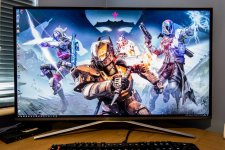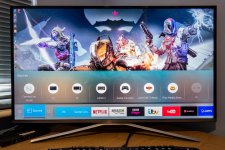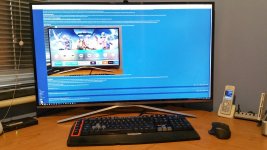Soldato
This is just a small mini review of the Samsung UE40KU6400 UHD TV used for PC / Console duty.
It's not going to be a scientific affair, more my setup and impressions using it as a PC monitor and for my Games consoles.
Reason for choosing a 40" UHD TV as a PC Monitor:
I recently purchased a 34" Superwide for work (Dell U3417W), this is a good enough monitor but if buying a monitor myself, I felt I'd like a bit more screen real estate.
Initially I looked at the LG 38" 21:9 monitor, but at £1K it seems poor VFM at the moment. Doing some quick man maths, I quickly worked out that a 38" superwide is pretty much the same width as a 40" display, so naturally I started considering 40" 4K Offerings which would be the same horizontal dimensions but add more height/pixels/real-estate.
After searching for a couple of hours, I accidentally stumbled across the Digital Foundry review of the Samsung 40" TV which concludes:
Initial Impressions

The monitor looks great on the desk, the stand has a brushed metal finish that matches the thin brushed lower bezel, and is just about the perfect height since the screen is quite tall it gives as comfortable a view as you can expect sat so close to a large display. I've tried raising it up but found it uncomfortable panning your head around the screen.
Just plugging in the PC immediately was impressive, the detail and clarity of the desktop was sublime with almost too much contrast with the out the box settings.
Setup and IQ Tweaking
For PC use, I am feeding it from an ASUS Strix GTX970 via a HDMI 2.0 cable.
The input has been set to 'PC' which automatically defeats just about all processing options, and then the HDMI colour space expanded to UHD Color (4:4:4).The Nvidia control panel was then used to set 8 bit colour and 4:4:4 colour encoding.
I confirmed all this using this simple test on a webpage ((4:4:4 Check).
The next step is due to my photography hobby I calibrate all my displays, in this case using an i1 Display Pro. As per the DF Review, you do indeed need to set the white balance to WARM 2 and from there it's just a small tweak of the RGB channels. The out the box calibration isn't too bad at all, if I switch between a default colour profile and my calibrated profile, the differences are only marginal.
I confirmed using imaging resources simple calibration test ((here) that I can just differentiate RGB values of 5 and 254, thus ensuring I can fully see all highlight detail and black level detail.
IQ Notes (PC Use)
Being a VA Panel, the black levels are excellent, although in PC Mode calibrated, all processing options that might minimise black levels on dark screens are defeated, so you do get a slightly elevated black level that is possible, but it's still very good indeed.
Viewing angles are much better than expected, my previous 28" TN panel had low but noticeable levels of clouding and loss of contrast in the corners due to the viewing angles, but this larger 40" manages to better that by a degree, and it is only the bottom corners that show signs of viewing angle colour/contrast drop off which is minor.
The only other viewing angle related issue (an artefact of sitting so close) is that backlight bleed is ever so slightly visible in the lower corners. If you move your head around this diminish to almost nothing, so viewing distance/angle can minimise those, however on the supplied stand that is the only observation and does not bother me at all.
Colour uniformity is largely superb, editing photo's is a joy, being able to have side by side comparisons and still see the entire image in enough detail has sped up my workflow no end.
Interestingly I have found input lag to be low even with 4:4:4 colour enabled @ 4K, I think when you configure the input as 'PC' it turns off all processing and you don't get any options such as gaming mode, I think it immediately goes for the lowest level of input lag (assumed 20ms).
Console Usage Notes
The other source I'm using at the moment is an Xbox One S. In this mode, it's using 4K @ 60hz in gaming mode, this drops the colour space ever so slightly so you aren't getting the full 4:4:4 colour, but as yet I have only been blown away by the colour and detail the monitor seems to pull out the image, and playing Gears of War 4 or Destiny has really been an improved experience.
Input lag is good (20ms apparantly) and most certainly in gaming mode has performed identically to both my monitors I normally use.
HDR and why it's not that amazing
Well, as per the DF review, this set although labelled as HDR is not a HDR capable TV in that it can't render HDR10 or Dolby Vision, so whilst it can accept a HDR signal, it won't technically get the most out of it.
However this leads me onto the whole subject of HDR which I feel to some degree is the emporers new clothes.
Having used a Samsung KS9000 for a truer HDR experience, I found that it's the ridiculous light levels (1000nits!) that really makes it too contrasty and actually hurts my eyes if gaming up close or using it as a PC monitor for any period of time. I do welcome the wider gamut, but would still reduce the white level down to the 200-250 nits level to be comfortable.
In that regard, the KU6400 is adequate, it's has a wider than normal colour gamut, which elevates it above most dedicated monitors immediately, and it's native contrast is very good (I think it measure somewhere between 3000-4000:1) and it's maximum output of around 400 nits is actually too much for me, I end up turning this down to be comfortable.
Other Features
And this is where the TV shines, it has a great set of apps built in, the Amazon prime video app allows Ultra HD streams to be played, and so far everything I've used seems to work well enough, it's not too slow and seems to find every media source on my network automatically:

And this is backed by a good enough inbuilt speaker setup, they are in a down firing configuration, with good volume, decent enough bass for general youtube/console use. I do however use a proper HiFi setup for PC music/gaming and 5.1 headphones for console use.
Conclusion
Technically this TV lacks many motion processing modes that do tend to get noted in reviews when using this as a TV, however, used in Gaming mode for consoles and setup for PC use as a monitor, this TV/Monitor seems to excel, pretty much as Digital Foundry say, the wider colour gamut, the black levels, and the general performance of this 4K monitor make it excellent value for money.
The fact it can make some use of a HDR signal is a bonus, and if you are someone that wants more real-estate and doesn't mind sitting close to a display, this is certainly very good VFM.
People who want 144hz PC gaming nirvana need look away, those monitors should 4K monitors should appear next year, but I suspect in a different league of pricing as well.
Overall, I'd give it 8/10 and couldn't be happier.
When 40" curved 144Hz HDR G-Sync monitors come out under £700 I will upgrade, but I sense that'll be a couple of years yet..
It's not going to be a scientific affair, more my setup and impressions using it as a PC monitor and for my Games consoles.
Reason for choosing a 40" UHD TV as a PC Monitor:
I recently purchased a 34" Superwide for work (Dell U3417W), this is a good enough monitor but if buying a monitor myself, I felt I'd like a bit more screen real estate.
Initially I looked at the LG 38" 21:9 monitor, but at £1K it seems poor VFM at the moment. Doing some quick man maths, I quickly worked out that a 38" superwide is pretty much the same width as a 40" display, so naturally I started considering 40" 4K Offerings which would be the same horizontal dimensions but add more height/pixels/real-estate.
After searching for a couple of hours, I accidentally stumbled across the Digital Foundry review of the Samsung 40" TV which concludes:
and at £480 with a5 year warranty, it seemed something worth trying, especially after seeing other feedback about the KU6400 (KU7000 in the US) around the web.While you don't get all the full bells and whistles of a higher end 4K set - HDR performance is limited here - the extra pixel density, high contrast ratio and low input lag allow for a superb gaming experience in standard dynamic range. Combined with Smart TV functionality and very good performance in most areas, the KU6400 easily outclasses high-end 1440p and 4K PC monitors costing considerable more, and works well as an affordable HDTV for UHD gaming.
Initial Impressions

The monitor looks great on the desk, the stand has a brushed metal finish that matches the thin brushed lower bezel, and is just about the perfect height since the screen is quite tall it gives as comfortable a view as you can expect sat so close to a large display. I've tried raising it up but found it uncomfortable panning your head around the screen.
Just plugging in the PC immediately was impressive, the detail and clarity of the desktop was sublime with almost too much contrast with the out the box settings.
Setup and IQ Tweaking
For PC use, I am feeding it from an ASUS Strix GTX970 via a HDMI 2.0 cable.
The input has been set to 'PC' which automatically defeats just about all processing options, and then the HDMI colour space expanded to UHD Color (4:4:4).The Nvidia control panel was then used to set 8 bit colour and 4:4:4 colour encoding.
I confirmed all this using this simple test on a webpage ((4:4:4 Check).
The next step is due to my photography hobby I calibrate all my displays, in this case using an i1 Display Pro. As per the DF Review, you do indeed need to set the white balance to WARM 2 and from there it's just a small tweak of the RGB channels. The out the box calibration isn't too bad at all, if I switch between a default colour profile and my calibrated profile, the differences are only marginal.
I confirmed using imaging resources simple calibration test ((here) that I can just differentiate RGB values of 5 and 254, thus ensuring I can fully see all highlight detail and black level detail.
IQ Notes (PC Use)
Being a VA Panel, the black levels are excellent, although in PC Mode calibrated, all processing options that might minimise black levels on dark screens are defeated, so you do get a slightly elevated black level that is possible, but it's still very good indeed.
Viewing angles are much better than expected, my previous 28" TN panel had low but noticeable levels of clouding and loss of contrast in the corners due to the viewing angles, but this larger 40" manages to better that by a degree, and it is only the bottom corners that show signs of viewing angle colour/contrast drop off which is minor.
The only other viewing angle related issue (an artefact of sitting so close) is that backlight bleed is ever so slightly visible in the lower corners. If you move your head around this diminish to almost nothing, so viewing distance/angle can minimise those, however on the supplied stand that is the only observation and does not bother me at all.
Colour uniformity is largely superb, editing photo's is a joy, being able to have side by side comparisons and still see the entire image in enough detail has sped up my workflow no end.
Interestingly I have found input lag to be low even with 4:4:4 colour enabled @ 4K, I think when you configure the input as 'PC' it turns off all processing and you don't get any options such as gaming mode, I think it immediately goes for the lowest level of input lag (assumed 20ms).
Console Usage Notes
The other source I'm using at the moment is an Xbox One S. In this mode, it's using 4K @ 60hz in gaming mode, this drops the colour space ever so slightly so you aren't getting the full 4:4:4 colour, but as yet I have only been blown away by the colour and detail the monitor seems to pull out the image, and playing Gears of War 4 or Destiny has really been an improved experience.
Input lag is good (20ms apparantly) and most certainly in gaming mode has performed identically to both my monitors I normally use.
HDR and why it's not that amazing
Well, as per the DF review, this set although labelled as HDR is not a HDR capable TV in that it can't render HDR10 or Dolby Vision, so whilst it can accept a HDR signal, it won't technically get the most out of it.
However this leads me onto the whole subject of HDR which I feel to some degree is the emporers new clothes.
Having used a Samsung KS9000 for a truer HDR experience, I found that it's the ridiculous light levels (1000nits!) that really makes it too contrasty and actually hurts my eyes if gaming up close or using it as a PC monitor for any period of time. I do welcome the wider gamut, but would still reduce the white level down to the 200-250 nits level to be comfortable.
In that regard, the KU6400 is adequate, it's has a wider than normal colour gamut, which elevates it above most dedicated monitors immediately, and it's native contrast is very good (I think it measure somewhere between 3000-4000:1) and it's maximum output of around 400 nits is actually too much for me, I end up turning this down to be comfortable.
Other Features
And this is where the TV shines, it has a great set of apps built in, the Amazon prime video app allows Ultra HD streams to be played, and so far everything I've used seems to work well enough, it's not too slow and seems to find every media source on my network automatically:

And this is backed by a good enough inbuilt speaker setup, they are in a down firing configuration, with good volume, decent enough bass for general youtube/console use. I do however use a proper HiFi setup for PC music/gaming and 5.1 headphones for console use.
Conclusion
Technically this TV lacks many motion processing modes that do tend to get noted in reviews when using this as a TV, however, used in Gaming mode for consoles and setup for PC use as a monitor, this TV/Monitor seems to excel, pretty much as Digital Foundry say, the wider colour gamut, the black levels, and the general performance of this 4K monitor make it excellent value for money.
The fact it can make some use of a HDR signal is a bonus, and if you are someone that wants more real-estate and doesn't mind sitting close to a display, this is certainly very good VFM.
People who want 144hz PC gaming nirvana need look away, those monitors should 4K monitors should appear next year, but I suspect in a different league of pricing as well.
Overall, I'd give it 8/10 and couldn't be happier.
When 40" curved 144Hz HDR G-Sync monitors come out under £700 I will upgrade, but I sense that'll be a couple of years yet..
Last edited:




